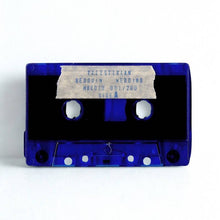
MBE Series / 2025 / C45 blue cassette + A6 photo-zine
This issue presents documentation by Majazz Project / Palestinian Sound Archive from events celebrating Palestinian Bedouin weddings across the Galilee in the 1970s.
Series of 200 resealable bags containing a C45 blu cassette + A6 photo-zine. Everything individually stamped and numbered.
The tape features an immersive field recording that sees performing Atef Swaitat (yarghul) and Abu Ali (lead vocals) two popular Bedouin wedding musicians continuing a long family tradition in Jenin and the north of historic Palestine.
In this issue we focus on the Yarghul and its role within the trance inducing music in Palestinian popular culture connecting it broadly with the pan-Mediterranean trance tradition, expressed through different patterns, but united by sonic rituals.
The Yarghul (also spelled arghul or yarghoul) is a traditional double-pipe reed instrument deeply embedded in the musical heritage of Palestine and neighboring regions. Its haunting, continuous drone and melodic capabilities make it a staple in various cultural expressions, notably in Bedouin weddings and trance-inducing musical performances.
It consists of two tubes:
Melody pipe: Equipped with finger holes, allowing the musician to play melodies.
Drone pipe: Longer and without finger holes, it produces a continuous drone note.
This setup creates a rich, layered sound reminiscent of a clarinet but with a more nasal, reedy tone. The yarghul's origins trace back to ancient Egypt, and it remains prevalent in Egypt, Palestine, Syria, and Jordan.
In Palestinian culture, the yarghul plays a significant role in traditional wedding ceremonies. It often accompanies the dabke, a communal line dance performed during celebrations. The instrument's continuous drone and melodic lines provide the rhythmic and melodic foundation for the dancers.
Tha A6 booklet presents photos of Palestinian Bedouin wedding celebrations from the Majazz Project archive.
Series of 200 resealable bags containing a C45 blu cassette + A6 photo-zine. Everything individually stamped and numbered.
The tape features an immersive field recording that sees performing Atef Swaitat (yarghul) and Abu Ali (lead vocals) two popular Bedouin wedding musicians continuing a long family tradition in Jenin and the north of historic Palestine.
In this issue we focus on the Yarghul and its role within the trance inducing music in Palestinian popular culture connecting it broadly with the pan-Mediterranean trance tradition, expressed through different patterns, but united by sonic rituals.
The Yarghul (also spelled arghul or yarghoul) is a traditional double-pipe reed instrument deeply embedded in the musical heritage of Palestine and neighboring regions. Its haunting, continuous drone and melodic capabilities make it a staple in various cultural expressions, notably in Bedouin weddings and trance-inducing musical performances.
It consists of two tubes:
Melody pipe: Equipped with finger holes, allowing the musician to play melodies.
Drone pipe: Longer and without finger holes, it produces a continuous drone note.
This setup creates a rich, layered sound reminiscent of a clarinet but with a more nasal, reedy tone. The yarghul's origins trace back to ancient Egypt, and it remains prevalent in Egypt, Palestine, Syria, and Jordan.
In Palestinian culture, the yarghul plays a significant role in traditional wedding ceremonies. It often accompanies the dabke, a communal line dance performed during celebrations. The instrument's continuous drone and melodic lines provide the rhythmic and melodic foundation for the dancers.
Tha A6 booklet presents photos of Palestinian Bedouin wedding celebrations from the Majazz Project archive.













